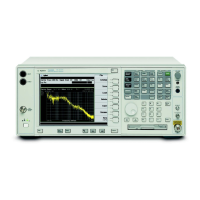Chapter 3 115
Making Measurements
Audio Distortion Measurement
Audio Distortion Measurement
This procedure describes how to make a Audio Distortion measurement. In this
measurement example, a signal generator is the UUT and is adjusted to deliver a
test signal. Audio Distortion measurement is used to measure and display the
amount of audio distortion applied to the audio signal by performing the ratio of
harmonic and noise power against fundamental power. The measurable frequency
range is from 20 Hz to 250 kHz.
CAUTION Make sure your input audio signal is under the allowed maximum safe input level
printed near the audio input connector.
NOTE You can make Audio Distortion measurements without a Power Meter since it is
the PSA that measures the Audio Distortion.
TIP Make sure the input and output impedance are matched. The PSA audio input has a
high impedance of 100 kΩ. The output impedance of your audio source may
impact the RMS level reading.
Measurement Procedure
CAUTION Press the Restart key to optimize the measuring receiver configuration if you make
any changes to the UUT or to the measuring receiver settings after you make your
first measurement.
Step 1. Setup the system. See Figure 3-23, “Audio Test Connection Diagram.”.
Step 2. Make sure you have selected
Measuring Receiver mode in the MODE key menu.
Step 3. Adjust the signal generator to the desired settings for your test.
Step 4. Press
Audio Frequency key. Wait for the measurement to be completed.
When the measurement is completed, the measurement result will display.
Step 5. To make an accurate measurement, select the appropriate Audio Range. See Step 6
on page 114.

